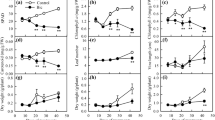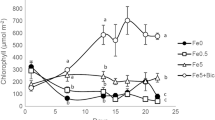Abstract
Bicarbonate has been regarded as a major factor for inducing Zn deficiency in lowland rice, but the mechanisms responsible for this effect are not yet fully understood. The objective of the present study was to test whether early effects of bicarbonate (HCO3 −)are inhibition of root growth due to the accumulation of organic acids induced by HCO3 −. Solution culture experiments were conducted using two rice cultivars differing in susceptibility to Zn deficiency, and four bicarbonate concentrations (0, 5, 10, 20 mM). Bicarbonate (5–20 mM) strongly inhibited root growth of the Zn-inefficient cultivar within 4 days of treatments. In contrast, root growth of the Zn-efficient cultivar was slightly stimulated with bicarbonate at 5–10 mM and not affected at 20 mM. The inhibitory effect of bicarbonate on root growth in the Zn-inefficient cultivar was mainly that of impairment of new root initiation rather than suppression of elongation of individual roots. Bicarbonate (5–20 mM) increased the concentrations of malate, succinate and citrate in the roots of both cultivars, but to a greater extent for the Zn-inefficient than for the Zn-efficient cultivars. The results suggest that the impairment of root growth was likely to be the initial action of bicarbonate in inducing Zn deficiency in lowland rice, and the inhibitory effect of bicarbonate on root growth of the Zn-inefficient cultivar might result from high accumulation and an insufficient compartmentation of organic acids in the root cells.
Similar content being viewed by others
References
Bertoni, G M, Pissaloux, A, Morard, P and Sayag, D R 1992 Bicarbonate-pH relationship with iron chlorosis in white lupine. J. Plant Nutr. 15, 1509–1518.
Bialczyk, J and Lechowski, Z. 1992 Absorption of HCO3 − by roots and its effect on carbon metabolism of tomato. J. Plant Nutr. 15, 293–312.
Chaudhry, F M, Alam, S M, Rashid, A and Latif, A 1977 Mechanism of differential susceptibility of two rice varieties to Zn deficiency. Plant and Soil 46, 637–642.
Coulombe, B A, Chaney, R L and Wiebold, W J 1984 Bicarbonate directly induces iron chlorosis in susceptible soybean cultivars. Soil Sci. Soc. Am. J. 48, 1297–1301.
Dogar, M A and Hai, Tvan 1980 Effect of N, P and HCO3 − levels in the nutrient solution on rate of Zn absorption by rice roots and Zn content. Z. Pflanzenphysiol. 98, 203–212.
Gout, E, Bligny, R, Pascal, N and Douce, R 1992 Regulation of intracellular pH values in higher plant cells. Carbon-13 and phosphorus-31 nuclear magnetic resonance studies. J. Biol. Chem. 267, 13903–13909.
Gout, E, Bligny, R, Pascal, N and Douce, R 1993 13C nuclear magnetic resonance studies of malate and citrate synthesis and compartmentation in higher plant cells. J. Biol. Chem. 268, 3986–3992.
Fleming, A L, Chaney, R L and Coulombe, B A 1984 Bicarbonate inhibits Fe-stress response and Fe uptake- translocation of chlorosis-susceptible soybean cultivars. J. Plant Nutr. 7, 699–714.
Forno, D A, Yoshida, S and Asher, C J 1975a Zinc deficiency in rice I. Soil factors associated the deficiency. Plant and Soil 42, 537–550.
Forno, D A, Yoshida, S and Asher, C J 1975b Zinc deficiency in rice II. Studies on two varieties differing in susceptibility to zinc deficiency. Plant and Soil 42, 551–563.
Fournier, J M, Alcántara, E and Guardia, M Dde la 1992 Organic acid accumulation in roots of two sunflower lines with a different response to iron deficiency. J. Plant Nutr. 15, 1747–1755.
IRRI 1971 Annual report for 1970, The International Rice Research Institute, Los banos, Philippines. pp 32–33.
IRRI 1972 Annual report for 1971. The International Rice Research Institute, Los Banos, Philippines. pp 43–46.
Lance, C and Rustin, P 1984 The central role of malate in plant metabolism. Physiol. Veg. 22, 625–641.
Lee, J A and Woolhouse, H W 1969a Root growth and dark fixation of carbon dioxide in calcicoles and calcifuges. New Phytol. 68, 247–255.
Lee, J A and Woolhouse, H W 1969b A comparative study of bicarbonate inhibition of root growth in calcicole and calcifuges grasses. New Phytol. 68, 1–11.
Lee, J A and Woolhouse, H W 1971 The relationship of compartmentation of organic acid metabolism to bicarbonate ion sensitivity of root growth in calcicoles and calcifuges. New Phytol. 70, 103–111.
McCray, J M and Matocha, J E 1992 Effects of soil water levels on solution bicarbonate, chlorosis and growth of sorghum. J. Plant Nutr. 15, 1877–1890.
Mengel, K, Breininger, M Th and Bübl, W 1984 Bicarbonate the most important factor inducing iron chlorosis in vine grapes on calcareous soils. Plant and Soil 81, 333–344.
Mengel, K and Bübl, W 1983 Distribution of iron in vine leaves with HCO3 − chlorosis. Z Pflanzenernaehr. Bodenkd. 146, 560–571.
Mengel, K and Geurtzen, G 1986 Iron chlorosis on calcareous soils: Alkaline nutritional conditions as the cause for the chlorsis. J. Plant Nutr. 9, 161–173
Mengel, K and Malissionvas, N 1981 Bicarbonate as inducing factor of iron chlorosis in vine (Vitis vinifera). Vitis 20, 235–243.
Qin S 1988 Zinc deficiency in lowland rice and its correction. In Diagnosis and Correction of Nutritional Disorders in Crops. Ed. S Qin. pp 118–128.
Romera, F J, Alcantara, E and Guardia, M Dde la 1992 Effect of bicarbonate, phosphate and high pH on the reducing capcity of Fe-deficient sunflower and cucumber plants. J Plant Nutr. 15, 1519–1530.
Römheld, V, Marschner, H and Kramer, D 1982 Responses to Fe deficiency in roots of “Fe-efficient” plant species. J. Plant Nutr. 5, 489–498.
Shi, Y, Byrne, D H, Reed, D W and Loeppert, R H 1993 Iron chlorsis development and growth responses of peach rootstocks to bicarbonate. J. Plant Nutr. 16, 1039–1046.
Tang, C X and Robson, A D 1993 pH above 6.0 reduces nodulation in Lupinus species. Plant and Soil 152, 269–276.
Yang, X, Römheld, V and Marschner, H 1993 Effect of bicarbonate and root zone temperature on the uptake of Zn, Fe, Mn and Cu by different rice cultivars (Oryza sativa L.) grown in calcareous soil. Plant and Soil 155/156, 441–445.
Yoshida, S and Tanaka, A 1969 Zinc deficiency of the rice plant in calcareous soils. Soil Sci. Plant Nutr. 15, 75–80.
Yoshida, S., Forno, D A and Bhadrachelam, A 1971 Zinc deficiency of the rice plants on calcareous and neutral soils in the Philippines. Soil Sci. Plant Nutr. 17, 83–87.
Yoshida, S, Forno, D A, Cock, J H and Gomez, K 1972 Routine methods of solution culture for rice. In Laboratory Manual for Physiological Studies of Rice, 2nd Ed., The International Rice Research Institute, Los Banos, Philippines. pp 53–57.
Author information
Authors and Affiliations
Rights and permissions
About this article
Cite this article
Yang, X., Römheld, V. & Marschner, H. Effect of bicarbonate on root growth and accumulation of organic acids in Zn-inefficient and Zn-efficient rice cultivars (Oryza sativa L.). Plant Soil 164, 1–7 (1994). https://doi.org/10.1007/BF00010104
Received:
Accepted:
Issue Date:
DOI: https://doi.org/10.1007/BF00010104




